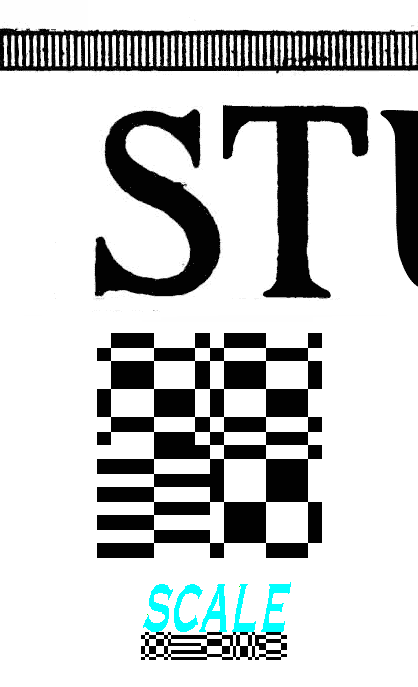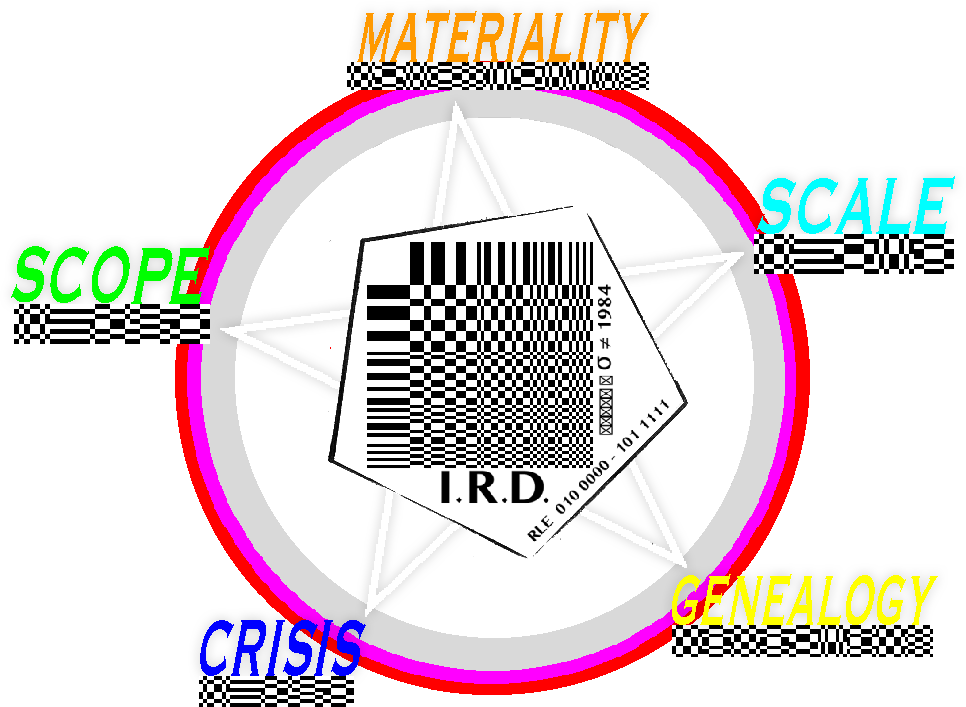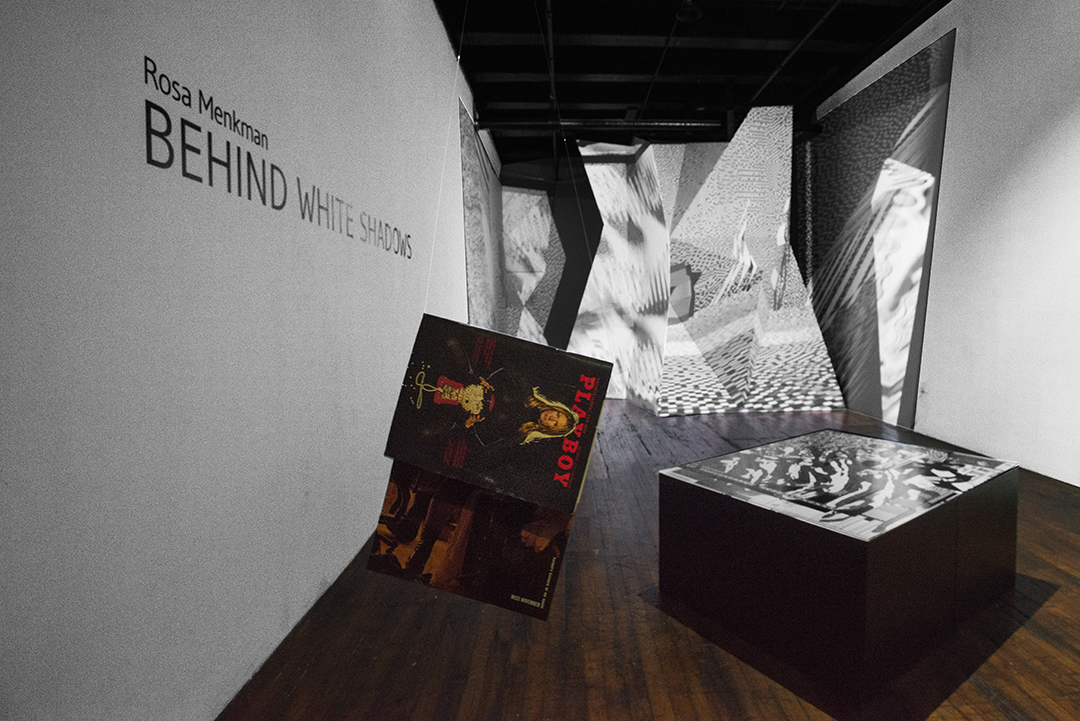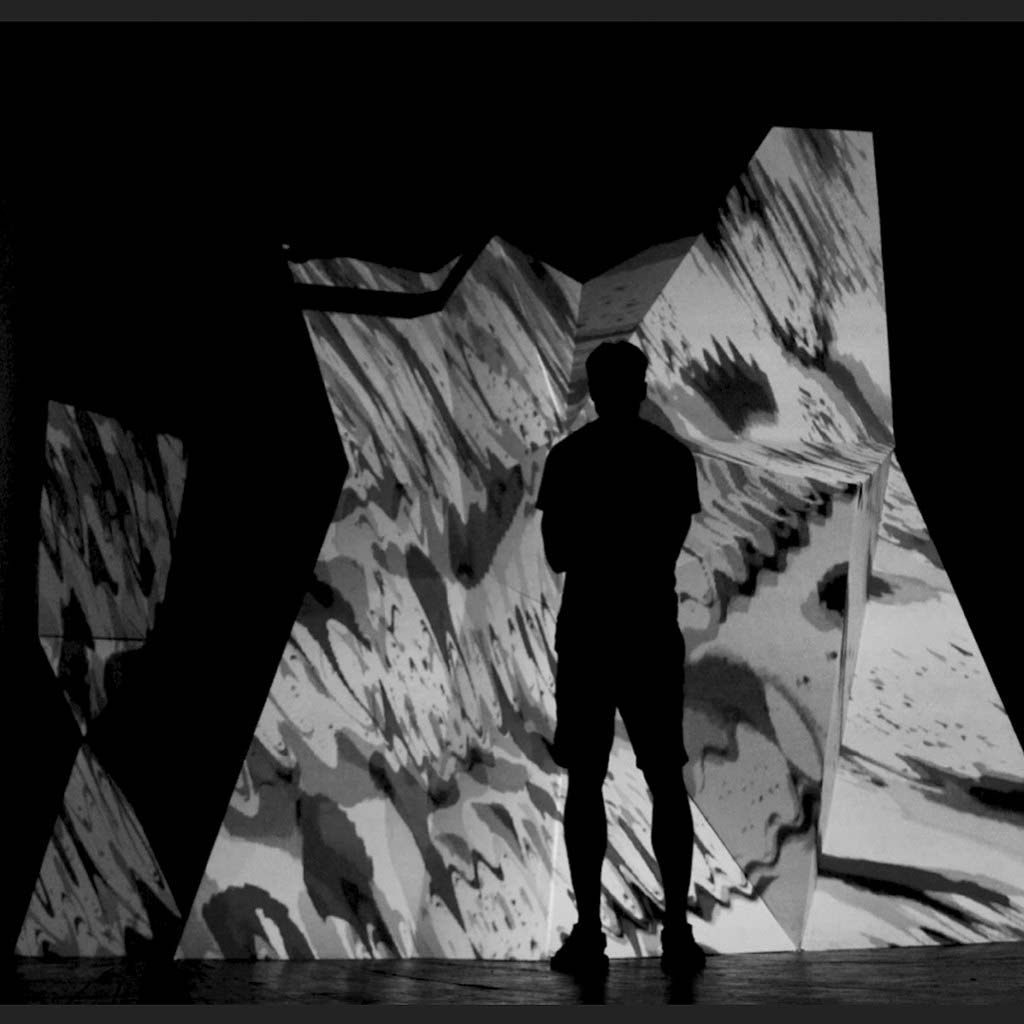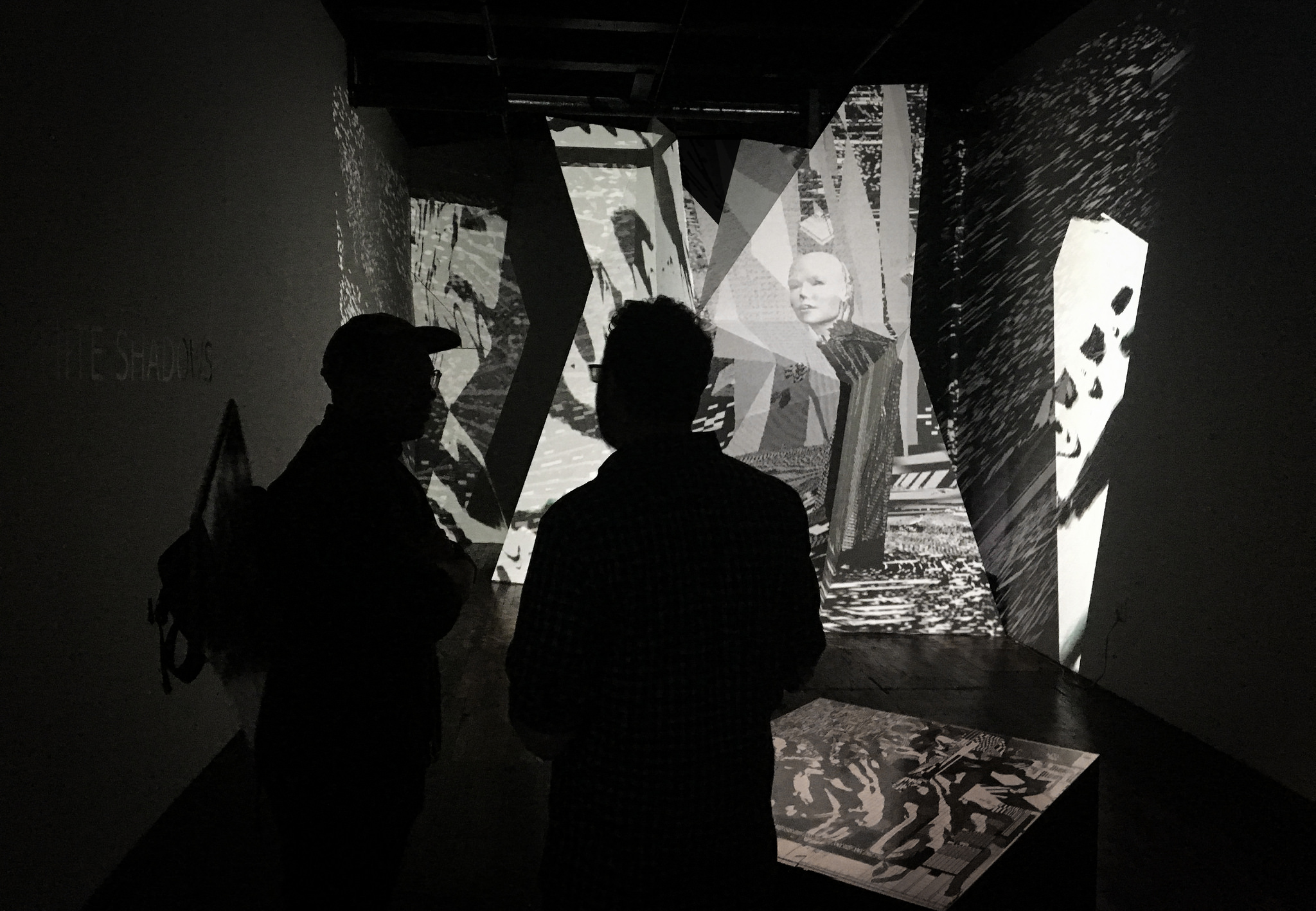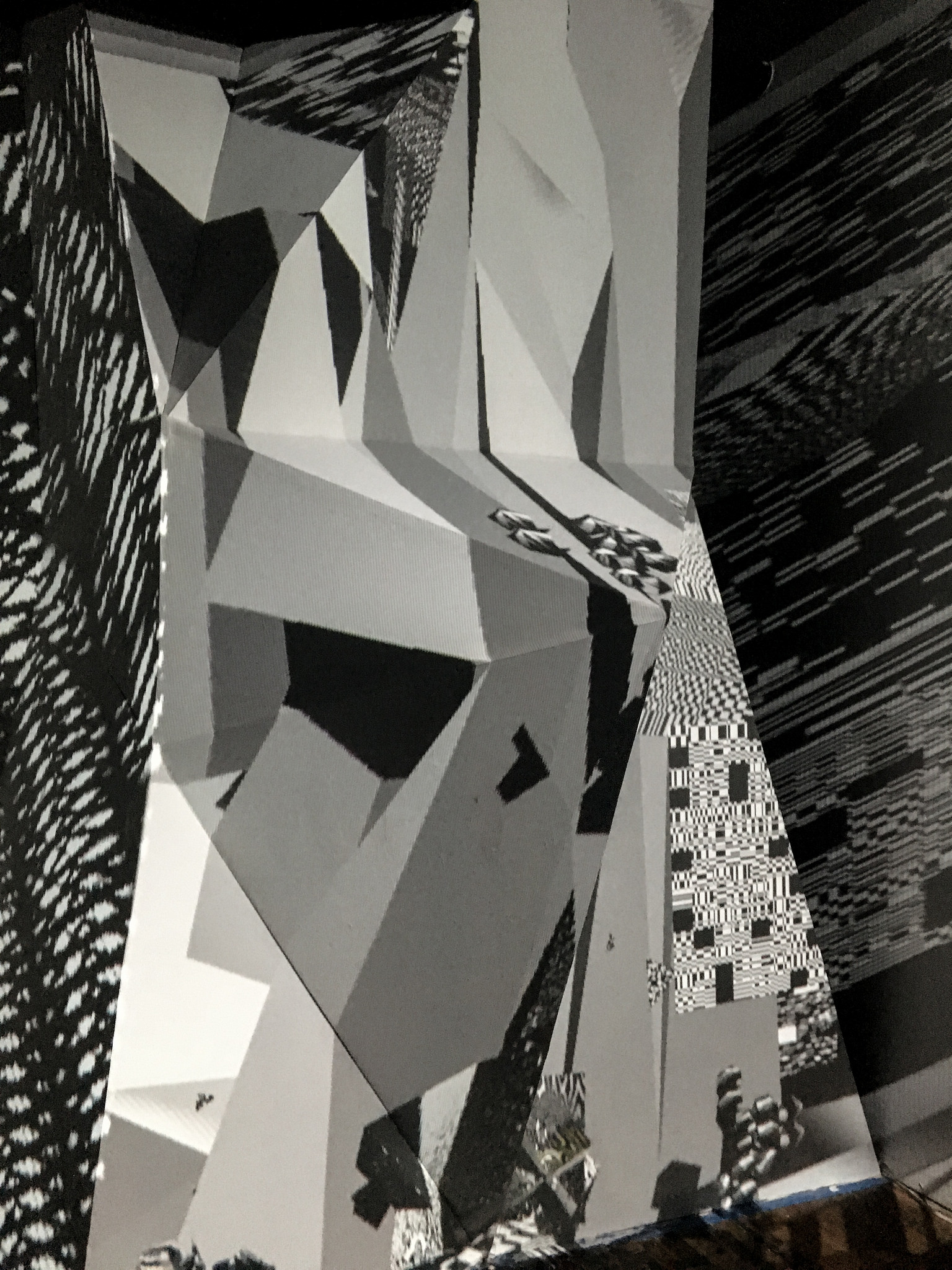CRISIS: (plural, additive) of the image
Transformations in the image render pipeline introduce (momentary) crisis, making certain ways of rendering and making visible im/possible.
Transformations in the image render pipeline introduce (momentary) crisis, making certain ways of rendering and making visible im/possible.
WRITTEN (THEORY)
>>> WORKING AXIOMS FOR A MEDIA ARCHEOLOgIST FRom ThE FutuRE (2024 - 2025)
>>> WORKING AXIOMS FOR A MEDIA ARCHEOLOgIST FRom ThE FutuRE (2024 - 2025)
ARTWORKS
>>> Spomenik (2017)
>>> Shredded Hologram Pen/Rose (2021)
>>> A Spectrum of Lost and Un/Named Colours (2023-2024)
>>> REFRACTIONS (2022 - 2024)
>>> Spomenik (2017)
>>> Shredded Hologram Pen/Rose (2021)
>>> A Spectrum of Lost and Un/Named Colours (2023-2024)
>>> REFRACTIONS (2022 - 2024)
Crisis of the Digital Image [[ constituted by phases of the image ]]
0000. OBSOLESCENCE OF ANALOGUE IMAGE PROCESSING
0001. TRANSITION FROM ANALOGUE TO DIGITAL
When digital mediations replaced the typically continuous analog signal with discrete data, artifacts like clipping, truncation, and quantization were introduced, raising questions about authenticity and integrity.
This shift led to a crisis of fidelity, challenging the reliability of the signal.
0010. PLATFORMED IMAGE
With the emergence of internet platforms and apps, the networked image arrives.
The networked image is subjected to not just Terms of Service (ToS), that can lead to censorship and filtering, it is also transcoded when uploaded (and sometimes even when reposted).
A protocol that alters the image in minor and often opaque ways (in terms of meta data alteration, cropping, re-compressing and user edits and additions). However, through iterative interactions of up and download, the image gradually degrades into a 'poor image’, riddled with trace evidence of its moves through the network.
At stake are the image’s authenticity, authorship, control and finally its legibility.
0011. CRISIS OF THE SYNTHETIC IMAGE
Transformations in the image render pipeline extend beyond artificial augmentations like “super-resolution” in devices such cellphones, which refers to the process of introducing additional patterns and details to the image that may not have a real-world origin.
The hyperimage may orginate from the real word, but is expanded by synthetic (computer generated) render layers that transform it into a dynamic, modular object. The hyperimage does away with the notion of a static image. Instead, the hyperimage is procedural construct, where some layers may even be rendered seperately; at clients end and remotely, fragmenting the image as a distributed, evolving, decentralized networked process consisting of assets that can be partially (re)rendered, on demand or progressively.
Moreover, synthetic images are increasingly rendered by machines for machines, particularly in the realm of computer vision.
Unlike traditional Visual Effects (VFX) and Computer-Generated Imagery (CGI), which enhance images for human perception, these synthetic images prioritize machine interpretation over human perception, blurring notions of fidelity, value, and legibility even further.
Computer vision and Generative Adversarial Networks (GANs) use synthesized datasets to train on. A process that redefines the traditional scope of capture (which used to be constrained by spectral, spatial, or temporal parameters) introducing synthetic datasets as a new parameter of scope.
This process of recursive synthesis ultimately leads to ‘limitless’ quantitative (but not qualitative) resolution:
synthetic resolution is optimized for efficiency and automation, but alienates the human viewer as it transforms visual information into constructs that no longer resemble a traditional image.
0000. OBSOLESCENCE OF ANALOGUE IMAGE PROCESSING
0001. TRANSITION FROM ANALOGUE TO DIGITAL
When digital mediations replaced the typically continuous analog signal with discrete data, artifacts like clipping, truncation, and quantization were introduced, raising questions about authenticity and integrity.
This shift led to a crisis of fidelity, challenging the reliability of the signal.
0010. PLATFORMED IMAGE
With the emergence of internet platforms and apps, the networked image arrives.
The networked image is subjected to not just Terms of Service (ToS), that can lead to censorship and filtering, it is also transcoded when uploaded (and sometimes even when reposted).
A protocol that alters the image in minor and often opaque ways (in terms of meta data alteration, cropping, re-compressing and user edits and additions). However, through iterative interactions of up and download, the image gradually degrades into a 'poor image’, riddled with trace evidence of its moves through the network.
At stake are the image’s authenticity, authorship, control and finally its legibility.
0011. CRISIS OF THE SYNTHETIC IMAGE
Transformations in the image render pipeline extend beyond artificial augmentations like “super-resolution” in devices such cellphones, which refers to the process of introducing additional patterns and details to the image that may not have a real-world origin.
The hyperimage may orginate from the real word, but is expanded by synthetic (computer generated) render layers that transform it into a dynamic, modular object. The hyperimage does away with the notion of a static image. Instead, the hyperimage is procedural construct, where some layers may even be rendered seperately; at clients end and remotely, fragmenting the image as a distributed, evolving, decentralized networked process consisting of assets that can be partially (re)rendered, on demand or progressively.
Moreover, synthetic images are increasingly rendered by machines for machines, particularly in the realm of computer vision.
Unlike traditional Visual Effects (VFX) and Computer-Generated Imagery (CGI), which enhance images for human perception, these synthetic images prioritize machine interpretation over human perception, blurring notions of fidelity, value, and legibility even further.
Computer vision and Generative Adversarial Networks (GANs) use synthesized datasets to train on. A process that redefines the traditional scope of capture (which used to be constrained by spectral, spatial, or temporal parameters) introducing synthetic datasets as a new parameter of scope.
This process of recursive synthesis ultimately leads to ‘limitless’ quantitative (but not qualitative) resolution:
synthetic resolution is optimized for efficiency and automation, but alienates the human viewer as it transforms visual information into constructs that no longer resemble a traditional image.
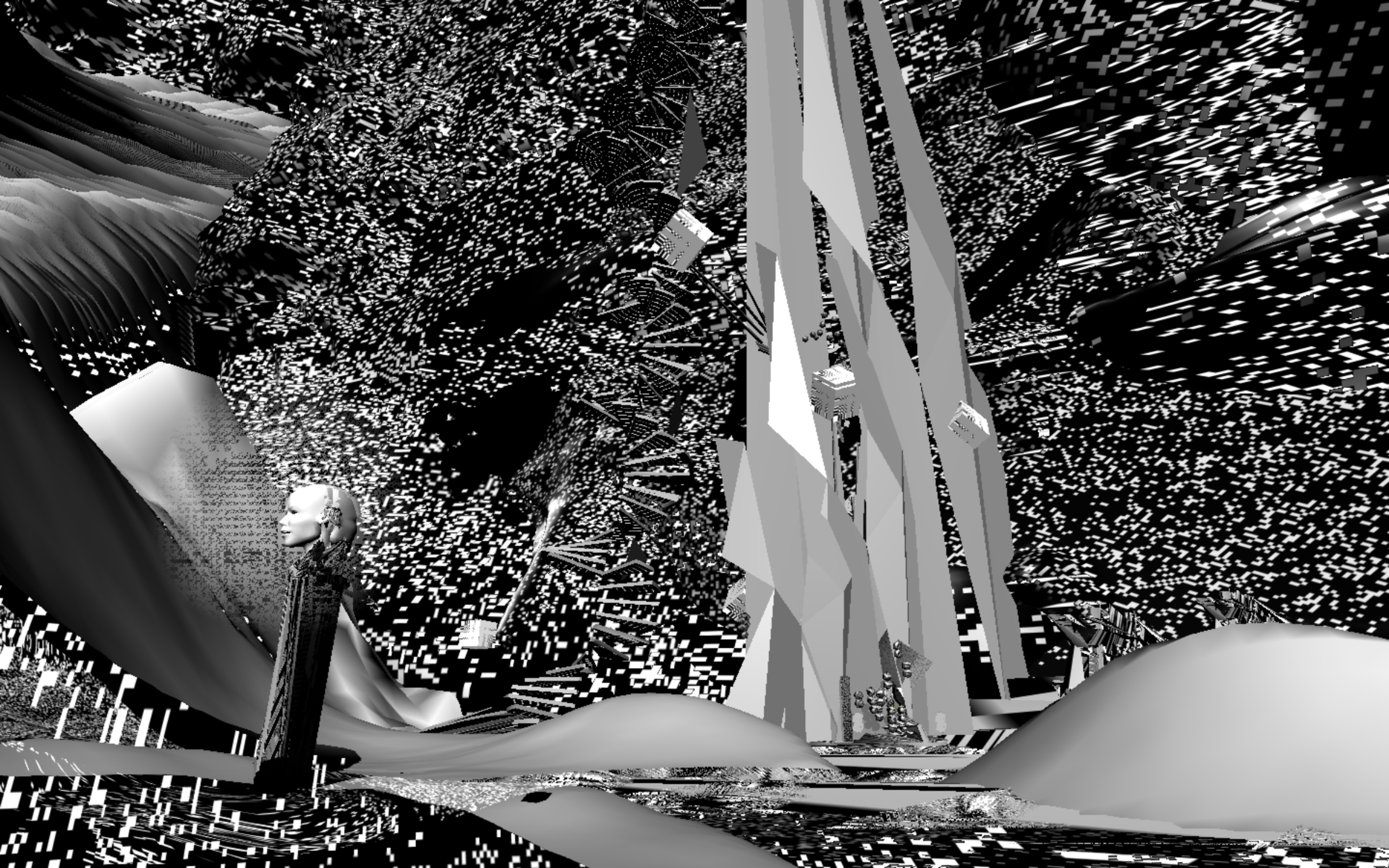
Angel of History in DCT:SYPHONING, standing in front of the Spomenik / Staircase to Nowegere (progress)
Spomenik (2017)
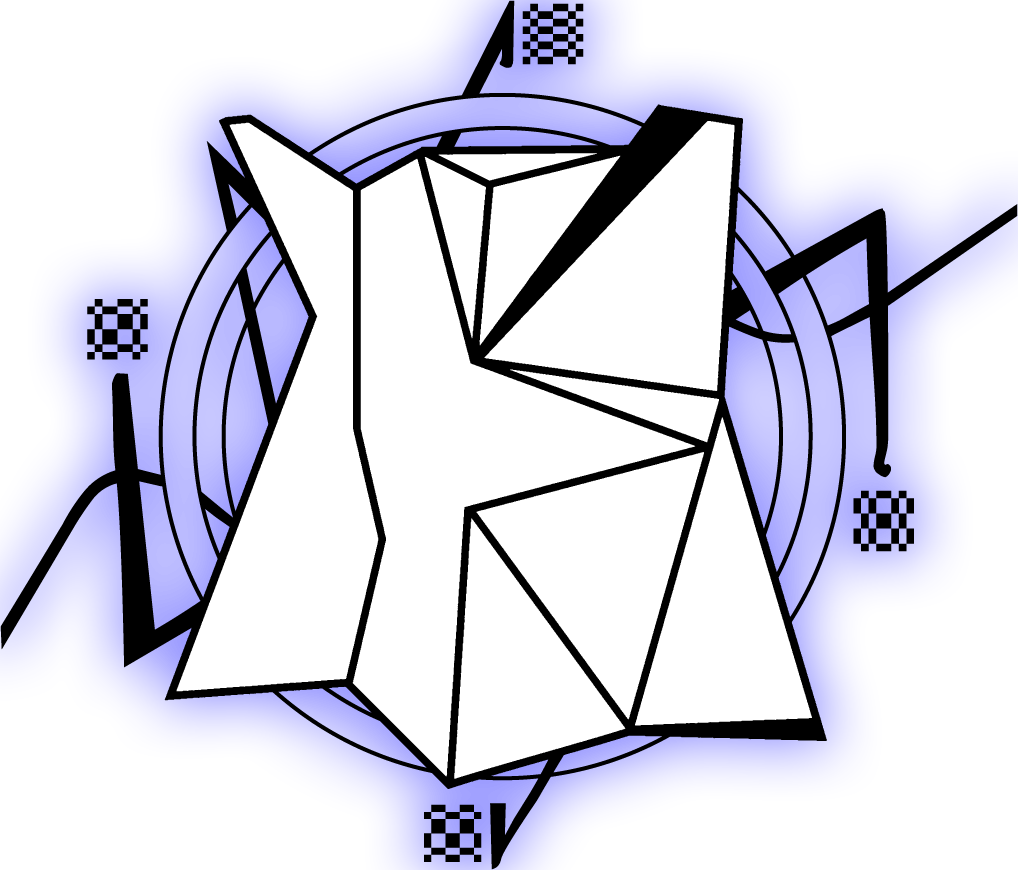 In DCT:SYPHONING, the Angel of History watches over 2 DCT Blocks, navigating the different ecologies of compression complexities.
In DCT:SYPHONING, the Angel of History watches over 2 DCT Blocks, navigating the different ecologies of compression complexities. When they enter higher complexities, the environment around them seems to collapse into a cairn of broken vectors, reminiscent of a Spomenik.
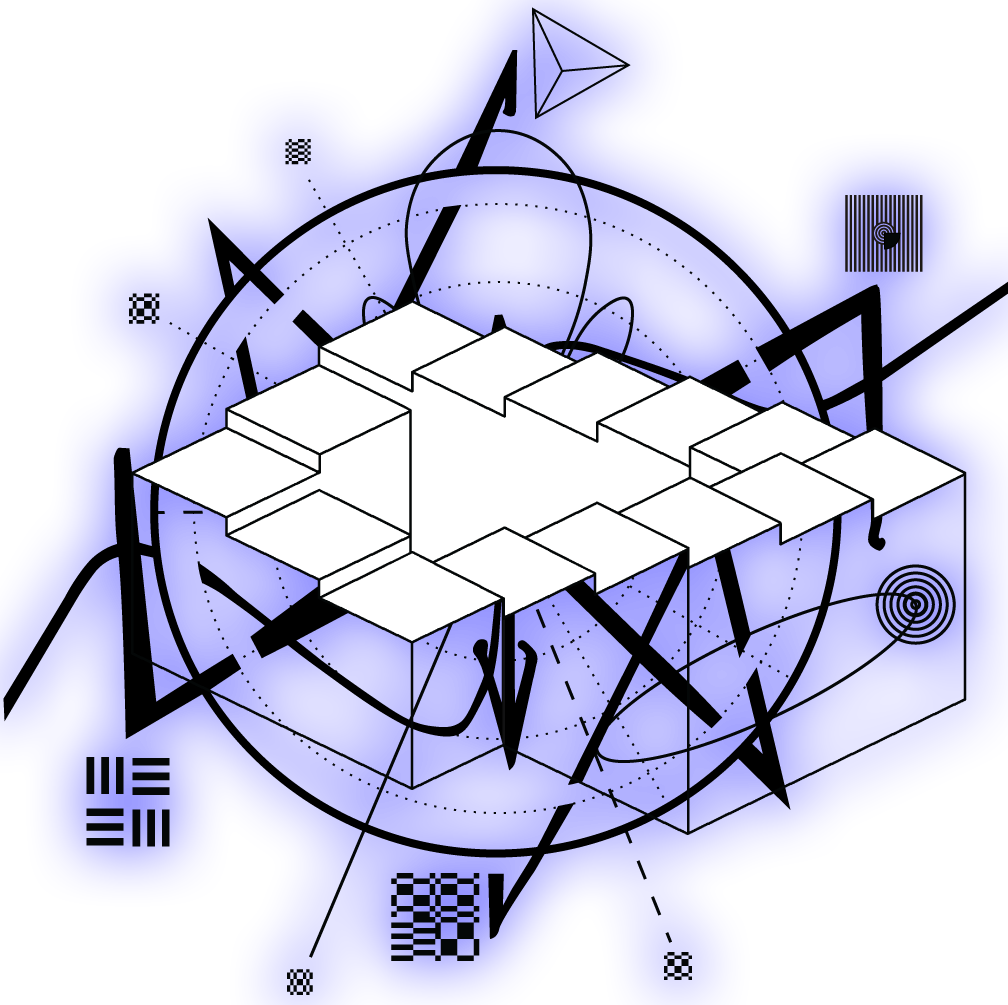
In Refractions
(in light and time),
the Spomenik, or cairn of broken vectors renders into a Pen/Rose Stairs to Nowhere when caibrated with the help of a CyCLOPS corner reflector network.
Centrepiece of my Behind White Shadows solo show
(Transfer Gallery NYC, 2017)
The Spomenik is a 3x4 meters large format sculpture, made out of triplex wood, painted white featuring projection mapped videos. The scultpure also hides a little cave in the back where visitors can play VR in peace.
A broken render, or monument of broken vectors for resolutions that will never be.
The Spomenik is inspired by the Spomeniks from the Balkan; brutalist monumental architecture, historically commemorating “many different things to many people”. The shape is inspired by Spomeniks such as Tjentiste and Ostra, but does not directly copy their shape but uses these structures as a reference.
This Spomenik is dedicated to resolutions that are impossible, such as ‘screen objects’ (shards) and the not (yet) implemented possibilities non quadrilateral screens have to offer.
This installed shard is three meter high, hiding a VR installation behind, running DCT:SYPHONING. The VR is accessible from the back of the Spomenik. The projection on the Spomenik is partially a mapped live stream from the VR.
The Spomenik also features textures of the Ecology of compression complexities, of which the map was layed out in front.
(Transfer Gallery NYC, 2017)
The Spomenik is a 3x4 meters large format sculpture, made out of triplex wood, painted white featuring projection mapped videos. The scultpure also hides a little cave in the back where visitors can play VR in peace.
A broken render, or monument of broken vectors for resolutions that will never be.
The Spomenik is inspired by the Spomeniks from the Balkan; brutalist monumental architecture, historically commemorating “many different things to many people”. The shape is inspired by Spomeniks such as Tjentiste and Ostra, but does not directly copy their shape but uses these structures as a reference.
This Spomenik is dedicated to resolutions that are impossible, such as ‘screen objects’ (shards) and the not (yet) implemented possibilities non quadrilateral screens have to offer.
This installed shard is three meter high, hiding a VR installation behind, running DCT:SYPHONING. The VR is accessible from the back of the Spomenik. The projection on the Spomenik is partially a mapped live stream from the VR.
The Spomenik also features textures of the Ecology of compression complexities, of which the map was layed out in front.
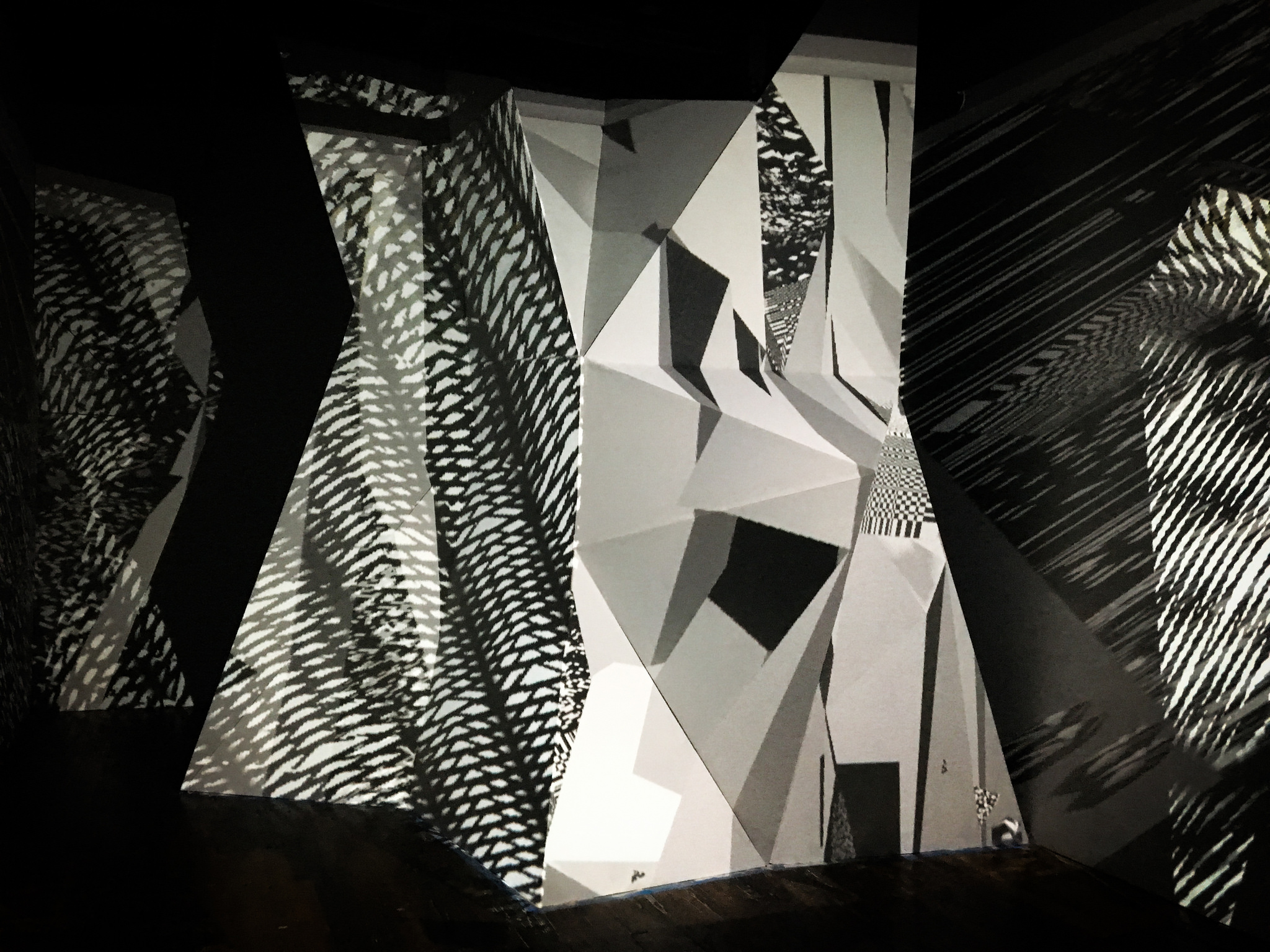
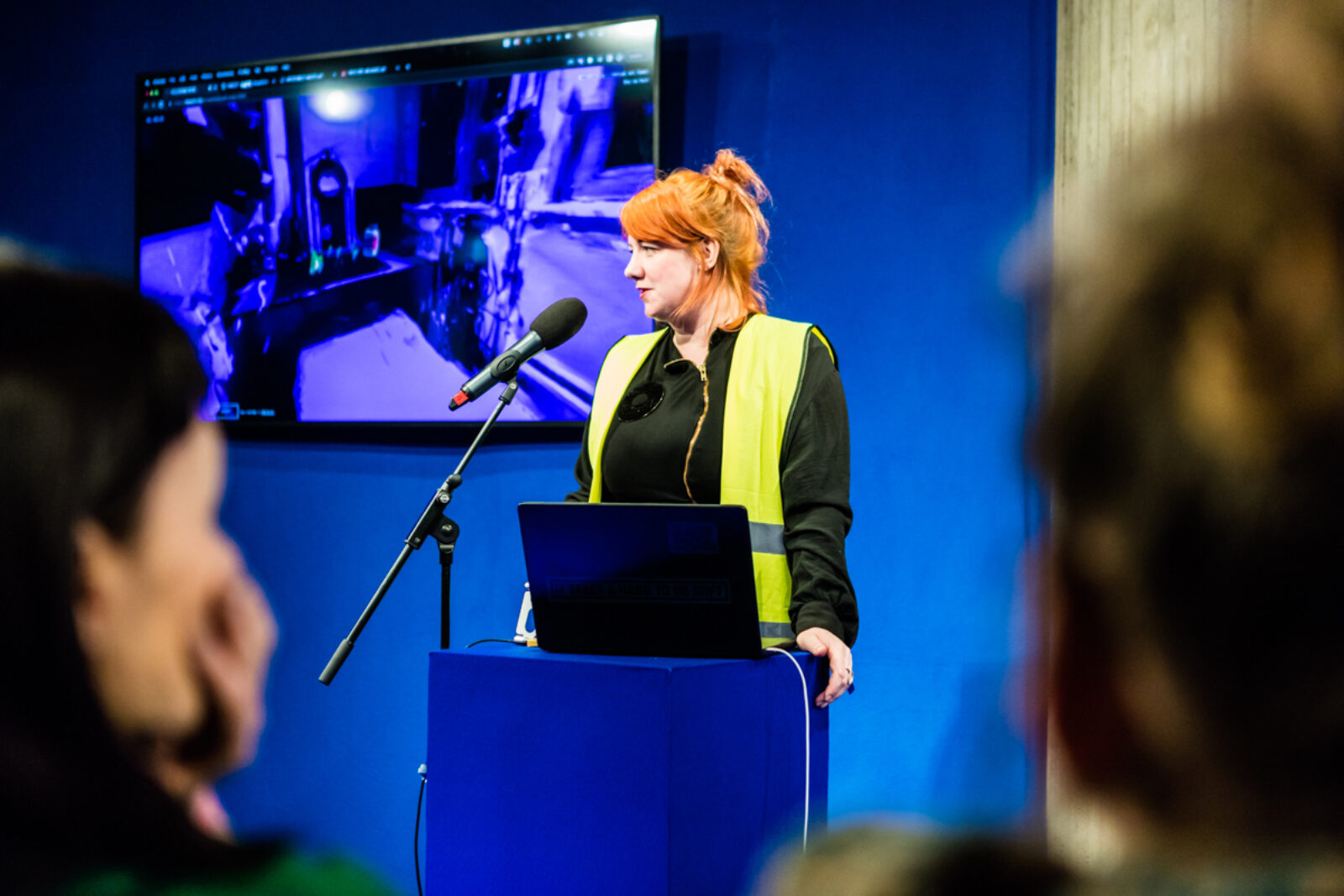 CCBYNCSA Laura Fiorio
CCBYNCSA Laura FiorioPerformance of the Shredded Hologram Rose during the Transmediale 2023.
The Shredded Hologram Pen/Rose (2021)
︎ Published in Angelaki: Shredded Hologram Rose PDF and ePuB
A hundred cycles from now, the Angel of History (now grown to become a media archaeologist) returns to her hyper–Yves Klein Blue–saturated cube, where she reflects on a day that began in misery: she fractured her beloved Hologram Rose.
Determined to repair her Hologram Rose, she visited the i.R.D. De/Calibration Target Target, a repository and memorial to dead codecs. With the mission to retrieve a baseline-JPEG quantization table and some Huffman maps. Tools that have long been obsolete but, she hopes, may help recalibrate the Rose.
She sets out to un-glitch her Hologram Rose... a symbol of Progress and onsolescence all at once.
☰☰☰☰☰☰☰☰☰☰☰☰☰☰☰☰☰☰☰☰☰
The Shredded Hologram Rose is inspired by "Fragments of a Hologram Rose," a 1977 science fiction short story by William Gibson.
The Hologram Rose was inspired and informed by Alan Warburtons RGBFAQ
An earlier short video work was created for the group exhibition Fragments of a Hologram Rose curated by Rick Silva for Feral File(29 June 2021). The work was extended for the opening keynote at IMPAKT Festival: The Curse of Smooth operations and NAC Memory Card festival. The Shredded Hologram Rose references the DeCalibration target and im/possible images.
︎ Published in Angelaki: Shredded Hologram Rose PDF and ePuB
A hundred cycles from now, the Angel of History (now grown to become a media archaeologist) returns to her hyper–Yves Klein Blue–saturated cube, where she reflects on a day that began in misery: she fractured her beloved Hologram Rose.
“From the shredded side of a Hologram, one can peek into the 3D objects’ Delta Axis. From this perspective, one can see the Holograms render objects, which form a repository of layered information about the Holograms provenance, metadata, and other information that the unscathed Hologram would never prevail.”
Determined to repair her Hologram Rose, she visited the i.R.D. De/Calibration Target Target, a repository and memorial to dead codecs. With the mission to retrieve a baseline-JPEG quantization table and some Huffman maps. Tools that have long been obsolete but, she hopes, may help recalibrate the Rose.
She sets out to un-glitch her Hologram Rose... a symbol of Progress and onsolescence all at once.
☰☰☰☰☰☰☰☰☰☰☰☰☰☰☰☰☰☰☰☰☰
The Shredded Hologram Rose is inspired by "Fragments of a Hologram Rose," a 1977 science fiction short story by William Gibson.
The Hologram Rose was inspired and informed by Alan Warburtons RGBFAQ
An earlier short video work was created for the group exhibition Fragments of a Hologram Rose curated by Rick Silva for Feral File(29 June 2021). The work was extended for the opening keynote at IMPAKT Festival: The Curse of Smooth operations and NAC Memory Card festival. The Shredded Hologram Rose references the DeCalibration target and im/possible images.
As performed at the transmediale 2023


 lightbox of a meeting between the Angel and the cyclops
lightbox of a meeting between the Angel and the cyclops In DCT:SYPHONING, the Angel of History watches over 2 DCT Blocks, navigating the different ecologies of compression complexities.
When they enter higher complexities, the environment around them seems to collapse into a cairn of broken vectors, reminiscent of a Spomenik.
If a myth is an algorithm
that functions as a tool
distinct to a time and place,
then, recursively,
an algorithm can become a myth,
written and transformed by iterative updates
and within procedural contexts.
that functions as a tool
distinct to a time and place,
then, recursively,
an algorithm can become a myth,
written and transformed by iterative updates
and within procedural contexts.
A century after Walter Benjamin introduced the Angel of History, image-processing technologies have evolved dramatically.
The Angel now traverses a landscape littered with piles of obsolete technology; an environment in which default settings corrupt improvements and trade-offs compromise quality. Caught in ripples of distortion and hindered by blind spots, the Angel finds it increasingly impossible to render the horizons around her.
Then one day, the Angel hears about a Cyclops-god who is said to have sacrificed an eye for the vision of his downfall. Fascinated by this lore of future demise, a perspective diametrically opposed to her fixation on past collapse, she sets off, hoping to learn from this Cyclops sense of future vision.
After exploring countless caves along the Mediterranean coast and finding several traces of cyclopes along the way, the Angel is shocked to finally learn about the location of Wodan’s Den; a grove near the place where her journey had first started.
She enters without hesitation, but immediately tumbles into what seems to be a recursive double-blind between future collapse and past obsolescence: everything around her turns to Spomenik ruins. With no sense of direction — up or down, forward or backward — the Angel is suspended, unaware that she has entered an abyss of her own Myopia.
Momentary panic sets in.
If her tools cannot render the data, perhaps another framework may help her recalibrate the glitch. In a search to find something, she scans the frequencies she usually keeps muted. And finally, deep within the C-band, she detects a faint echo: a CyCLOPS.cy corner reflector, part of a decentralized AI imaging system that aligns BLOb data across time and space.
At last, AI codecs - built by machines for machines - help her restore an image: what renders is a PenRose Stairs to Nowhere (Progress), a procedural perspective that never fully resolves.
DEVELOPMENTS
My EMAP residency at NeMe in Limassol, Cyprus in 2022, made this exploration possible. During this residency I worked with Taietzel Ticalos, Marios Isaakidis, and Irini Mirena Papadimitriou.
The sound is made by Debit.
A dialogue with NeMe.
The development of REFRACTIONS involved collaborations and iterations across multiple locations and formats:
REFRACTIONS VIDEO INSTALLATION WITH SOUNDTRACK BY DEBIT AND CUSTOM SIGILS OR WALLPAPER
07.11.2024 —30.03.2025. End and Beginning @ iMAL, Brussels, Belgium.
17/112024— Artist talk about Refractions, Schafhof Munich, Germany.
14-15/112024 — AI MADE ME DO IT, Exhibition @ studio3 Institute for Experimental Architecture, Innsbruck University, Austria.
08/08/2023 — Refractions in Light and Time lecture performance at RMIT, Melbourne. 27/09/2024—01/12/2024. Attention upon Arrival @ Schafhof, Munich, Germany.
10-14/5/23 —Refractions in Light and Time, 3D environment installation with custom wallpaper, shown WRO, Poland20/09/2023 —11/11/2023. Refractions in Light and Time, 3D environment installation with custom wallpaper, shown at RIXC, Riga, Latvia.
18/01/2023 — 21/01/2023. Refractions in Light and Time, 3D environment installation with custom wallpaper, shown at NeMe.
WITH KIMCHI AND CHIPS:
15/03/2023 —17/03/2023. Cyclops Retina, in collaboration with Kimchi and Chips, The Beams, London.
24/03/2023 —Artist talk. The Beams, London.
My EMAP residency at NeMe in Limassol, Cyprus in 2022, made this exploration possible. During this residency I worked with Taietzel Ticalos, Marios Isaakidis, and Irini Mirena Papadimitriou.
The sound is made by Debit.
A dialogue with NeMe.
The development of REFRACTIONS involved collaborations and iterations across multiple locations and formats:
REFRACTIONS VIDEO INSTALLATION WITH SOUNDTRACK BY DEBIT AND CUSTOM SIGILS OR WALLPAPER
07.11.2024 —30.03.2025. End and Beginning @ iMAL, Brussels, Belgium.
17/112024— Artist talk about Refractions, Schafhof Munich, Germany.
14-15/112024 — AI MADE ME DO IT, Exhibition @ studio3 Institute for Experimental Architecture, Innsbruck University, Austria.
08/08/2023 — Refractions in Light and Time lecture performance at RMIT, Melbourne. 27/09/2024—01/12/2024. Attention upon Arrival @ Schafhof, Munich, Germany.
10-14/5/23 —Refractions in Light and Time, 3D environment installation with custom wallpaper, shown WRO, Poland20/09/2023 —11/11/2023. Refractions in Light and Time, 3D environment installation with custom wallpaper, shown at RIXC, Riga, Latvia.
18/01/2023 — 21/01/2023. Refractions in Light and Time, 3D environment installation with custom wallpaper, shown at NeMe.
WITH KIMCHI AND CHIPS:
15/03/2023 —17/03/2023. Cyclops Retina, in collaboration with Kimchi and Chips, The Beams, London.
24/03/2023 —Artist talk. The Beams, London.
 Refractions installed at Schafhof, Munich, 2024.
Refractions installed at Schafhof, Munich, 2024.refractions got reviewed in de Witte RAAF #233
“[...] Menkman’s film draws a forceful analogy with the Germanic high‑god Wodan, who sacrificed an eye in order to glimpse the future and continued on as a half‑blinded cyclops. Faith in progress and technological determinism can distort—and even blind—our vision.”




Documentation of our first Cyclops research in Serifos, at the Cyclops throne and inside the cyclops cave.
 Locations of different lineages and families of cyclopses I traced all over Europe
Locations of different lineages and families of cyclopses I traced all over Europe plaque of the CyCLOPS.cy Strategic Research Infrastructure Unit, an optical infrastructure network in Cyprus supporting the Sentinel satellite
plaque of the CyCLOPS.cy Strategic Research Infrastructure Unit, an optical infrastructure network in Cyprus supporting the Sentinel satellite  Documentation of my visit of CyCLOPS.cy in Limassol at the polytechnical University
Documentation of my visit of CyCLOPS.cy in Limassol at the polytechnical University Locations of the 12 CyCLOPS.cy corner reflector Network
Locations of the 12 CyCLOPS.cy corner reflector Network


ALEV01 + ALEV02
AKMS01 + AKMS02
SOUN01 + SOUN02
ASGA01 + ASGA02
MATS01 + MATS02
TROU01+ TROU02 - INACCESSIBLE BECAUSE MILITARY ZONE -
GOOGLE SATELLITE SCREENSHOTS
GOOGLE SATELLITE SCREENSHOTS
12 CyCLOPS.cy Corner Reflectors (2024)
prints Installed at Schafhof, Freising (by Munich, 2024)
optical infrastructure network, that supports the Sentinel satellite data to be calibrated.
optical infrastructure network, that supports the Sentinel satellite data to be calibrated.
Cyclops Retina (2023) In collaboration with Kimchi and Chips.
Commissioned Install for Thin Air @The Beams, on till the 4th of June, London, UK.
In Cyclops Retina, Kimchi and Chips and Rosa Menkman combine their contrasting research into light as both a material and neurological phenomena to create an experimental video essay presented in an experimental format. The specially commissioned narrative written and narrated by Menkman takes us on her journey into the cave of a cyclops so that she might learn how to see into the future. This journey is illustrated by millions of beams of light which are merged in the haze to create floating graphics in the air. The installation and narrative delve into unconventional modes of vision, pushing boundaries and exploring new ways of experiencing light and perception.
Commissioned Install for Thin Air @The Beams, on till the 4th of June, London, UK.
In Cyclops Retina, Kimchi and Chips and Rosa Menkman combine their contrasting research into light as both a material and neurological phenomena to create an experimental video essay presented in an experimental format. The specially commissioned narrative written and narrated by Menkman takes us on her journey into the cave of a cyclops so that she might learn how to see into the future. This journey is illustrated by millions of beams of light which are merged in the haze to create floating graphics in the air. The installation and narrative delve into unconventional modes of vision, pushing boundaries and exploring new ways of experiencing light and perception.







